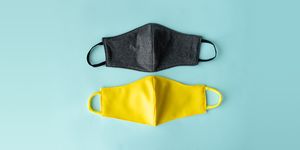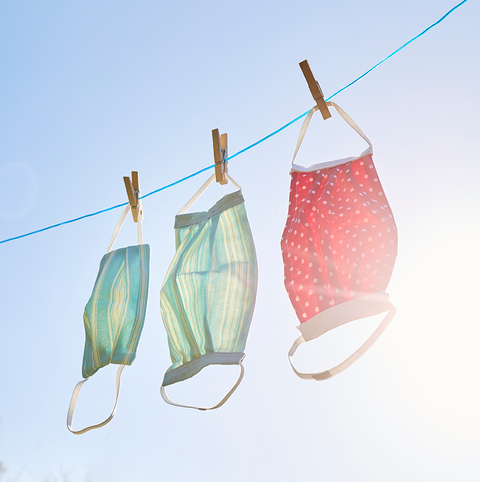You’re a thousand percent, totally on board wearing a mask in public, especially where it’s not possible to stay six feet away from everyone. That’s because not only is wearing a mask or face covering the most effective tool we have right now to stop the spread of COVID-19, but it’s like carrying a giant sign that reads, “I care about the people around me and want everyone to stay healthy!”
In fact, studies like this one in The Lancet have found that wearing a mask could result in a “large reduction in the risk of infection,” as much as 65%, according to scientists at UC Davis. That’s largely because it prevents a person who may not realize they have COVID-19 from accidentally breathing it out into the airspace of someone else, who then breathes it in. Data from MIT shows that tens of thousands of lives would have been saved had masks been required by businesses that interacted with the public earlier in the pandemic.
So wearing a mask is a no-brainer, but can we not with the zits and blackheads and skin irritation on our lower faces when we wear a mask for a prolonged period of time? Sure, “maskne,” as it’s been dubbed, is a small price to pay for lowering the rate transmission of COVID-19, but wouldn’t it be nice not to have to pay it?
First, let’s break down what maskne is:
Maskne refers to pimples, blackheads, and other irritation on your cheeks, chin, nose, and around your mouth that you wouldn’t be having but for your face covering. “Masks cause breakouts due to the combination of friction, heat, moisture, and clogged pores,” says dermatologist Howard Sobel, MD, founder of Sobel Skin in New York City.
But maskne isn’t only acne, says Dr. Sobel. “Maskne is triggered by friction from your mask, so it can set off other dermatological conditions that are not just breakouts,” he says. “And can appear more as rashes such as contact dermatitis, seborrheic dermatitis, or hives.”
And if you have a pre-existing skin condition, such as rosacea, wearing a mask for a long time can cause a flare. “That’s not technically acne, but still an irritation to the skin from a mask that causes the skin to become red, inflamed and look similar to acne,” but is treated differently. Dr. Sobel says he’s also seen lots of yeast infections on the face that result in redness with pustules that look similar to acne.
Who is most likely to get maskne?
Anyone with any skin type can get it. “However, people who already suffer from skin conditions such as rosacea can have worse maskne than others, as wearing a mask exacerbates a problem with the skin that is already there,” says Dr. Sobel, who adds that folks who are already acne prone or have oily skin are also on the hook. In other words, you can have maskne on top of your regularly scheduled acne or other issues, for even more inflamed skin.
Slather on the sunscreen, other facial products and makeup, and your odds of maskne go up even more. “Wearing makeup can also make someone more prone to developing maskne because as makeup gets trapped on the skin under your mask, it may sink more into your pores and cause more breakouts.” What’s more, dead skin cells, which you shed all day, may not have anywhere to fall and thus further clog your pores, says Dr. Sobel.
Tips for preventing and treating maskne:
Visit the dermatologist. A yeast infection, dermatitis, acne, and other mask-related flareups can be hard to tell apart. “It is important to differentiate whether it is acne or rosacea or something else because these conditions are treated differently,” says Dr. Sobel. Once you know the exact issue, you and your doc can figure out if you need a topical medication, a habit change, or both.Pick the right mask. In general, Dr. Sobel likes 100% cotton masks because they are breathable, and so less likely to make you sweat. Lexie Sachs, the director of the textile lab at the Good Housekeeping Institute agrees and recommends multiple layers of lightweight cotton, which is both breathable and protective. That said, if you’re working out, a mask in a wicking fabric is a good call. “You’ll notice you don’t see cotton in workout clothes because it holds onto moisture and stays wet,” says Sachs. “So if you’re sweating, the sweat will stick to the mask. With the right knit, polyester can be moisture wicking.” Check out some of the Good Housekeeping Institute’s favorite breathable masks here. If its likely friction is causing your skin irritation, pick a mask that feels smooth on the back of your hand, advises Sacks.Toss disposable masks. The word disposable should be a tipoff but many people reuse these—bad idea if you’ve got maskne concerns, because you’re putting makeup and dirt from yesterday right back on your face, says Dr. Sobel. Wash your masks. The Center for Disease Control’s recommendation to wash them “regularly” is a little vague. Sachs says that it depends on how much you’re wearing them. “Obviously you need to consider the safety and remove it wash it properly if the virus could potentially be on the fabric,” she says. “But in terms of maskne specifically, consider how long you’re wearing it and whether you’re sweating. If you’re at work and have the mask on all day long, then wash after each use. If you’re just throwing it on for a few minutes at a time then that likely isn’t necessary.” The Good Housekeeping Institute recommends using hot water. Find the full how-to here.Carry a spare. “If you are wearing a mask to exercise or sweat during the day, change your mask right away after the usage,” says Dr. Sobel. Sachs agrees. “Putting on a fresh, clean mask as opposed to wearing the same one for hours on end seems like an easy way to avoid maskne.Step up your skincare routine. After you’ve figured out with your doc if you’ve got true acne or some other kind of irritation or infection, you can figure out what products would help. Start with a gentle cleanser, says Dr. Sobel, who likes Neutrogena Oil-Free Acne and Redness Facial Cleanser, which has salicylic acid to ungunk pores, but also soothing aloe and chamomile to reduce redness. If you’re pretty sure it’s acne and not some other condition, “Look for ingredients such as: salicylic acid, benzoyl peroxide and retinoids,” says Dr. Sobel. (Skip the benzoyl peroxide and glycolic acid if you’ve got sensitive skin. If it’s irritation that’s causing your redness, a hydrocortisone cream or one that contains aloe and hydrocortisone may help reduce inflammation, he says. Finally, products containing bio hyaluronic acid, such as Dr. Sobel’s Skin Rx Bio Hyaluronic Moisturizing Cream is super moisturizing and can help restore the skin barrier that is disrupted by wearing a mask, he says.
Bottom line: Wear a mask, but keep it clean, dry, and fresh, and see a doctor to ID what exactly is causing your maskne, so you get the right treatment.



